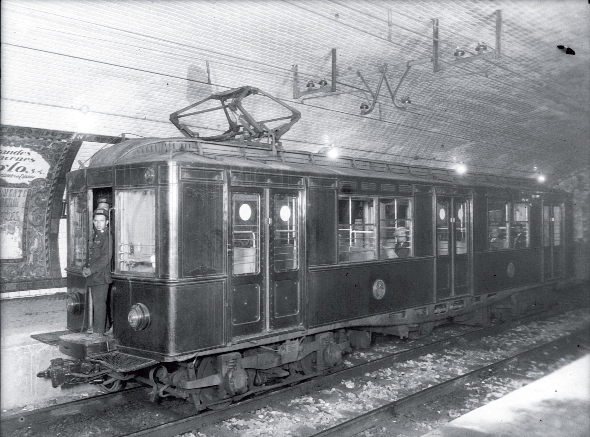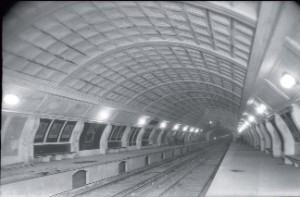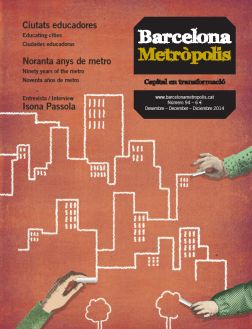Joan Coll, author of this article, is the director of CultRuta
Manuel Marina, responsible for documentation, holds a Diploma in Tourism and leads guided tours of the metro system
Tunnels and stations in disuse, old artistic tiling, advertising from past eras, murmurs of water and even ghost legends tell the story of the Barcelona metro.

© Brangulí / Arxiu Nacional de Catalunya
Gran Metro train at Lesseps station sometime between 1925 and 1930. The original trains, refitted, continued in operation until the late 1980s.
The history of a society, a town or a group is often based on unique, representative, dramatic or happy events, which have usually occurred on the face of the Earth. However, during the 19th and 20th centuries, industrialisation and urban life in what we call the civilised world brought substantial changes to the day-to-day of its inhabitants. As a result, some people live a part of their lives within the Earth’s crust.
These new-found lifestyles, which still number within the minority, are not usually studied as part of modern history. However, the general public recognise their significance. Proof of this is to be found in the growing number of leisure activities taking place underground. Bunkers, tunnels, mediaeval dungeons, fluvial deposits and, of course, underground train networks are now amongst the tourist attractions available in major cities throughout Europe.
Barcelona is not one to be left out. Coinciding with the ninetieth anniversary of the opening of the city’s first metro system, Transports Metropolitans de Barcelona (TMB) and CultRuta now offer guided tours that provide a first-hand look at the historical, artistic and human legacy of tunnels, platforms and trains that day-to-day, whether we use them or not, are behind the incessant buzz that exists beneath the streets of Barcelona. These tours serve as a pretext to get us walking through the metro system. They oblige us to stop and have a good look at the details of the tiling, hear the murmur of water on the other side of the tracks, or ask about that ever-present clattering sound between two stations – signs of a subterranean history of the city that escape the attentions of most of us.

© Generalitat de Catalunya / Arxiu Nacional de Catalunya
Entrance to the Correus station at the start of the Civil War, with a notice warning that it is not fit for use as a bomb shelter.
A prime example would be the Fontana station, opened in 1925, months after the entry into service of the section of track between Plaça de Catalunya and Plaça de Lesseps. Its entrance is unique and includes a great many stairwells and escalators that give most users a real understanding of how deep the metro goes down. But few will be aware of one of the metro’s jewels, found at one end of the 92-metre long platform: the entrance arch to the tunnel in the direction of Trinitat Nova still has the painted blue tiles placed there in 1924. They bear the logo and corporate colours of the then privately owned company Grand Metropolitan Barcelona (GMB). Anyone who likes the logo will also find it on wrought iron railings in the entranceways to the Liceu station.
Almost all the rest of the original decor on the majority of this historic line (which forms the core of today’s L1 and L3) has disappeared in refurbishment works, although sometimes it has not been lost but just hidden. Behind ventilation ducts, synthetic panels, precast components and vending machines are (at least for the time being) the original tiles – white or coloured, large or small, dirty or cared for – that still perform their decorative and hygienic functions, even if hidden from our view.
This is not a mere caprice on the part of the metro management. The concealment, removal or replacement of these elements has been part of providing us with one of the most comfortable, accessible and well-lit systems, compared against other cities with close to a century of metro history. Paris and London serve as prime examples. In the French and British capitals historic stations are conserved virtually identical to their original state, yet we could never enter them in a wheelchair, as we can in Fontana thanks to the many lifts available there.

© Dani Codina
A group of visitors to the guided tours organised by Transports Metropolitans de Barcelona and CultRuta.
Of course, this modernisation has led to modifications to the system: changes in lines, platforms, walkways or entire stations. A case in point is the old Aragó, present-day Passeig de Gràcia station. Where three lines run today, there was until a few decades ago one end of an inverted Y-shaped intersection of the Gran Metro, forking in the direction of Liceu or Correus. With the growth of the system, the north siding was left in place for the independent L4, which is linked to the L3 via that endless corridor that any regular user takes pains to avoid. The insurmountable narrowness, straightness and claustrophobia of this corridor is not the product of an urban planner’s bad-hair day, but rather the result of a very mundane circumstance: when the underground connection between these lines was made, the subsoil already housed an underground car park; the only possible link between the two lines that would avoid parked cars was the tunnel with sturdy beams that held up the two city blocks of the Cerdà Plan.
Other stations simply once were and now are no longer. A case in point is Correus, which opened in 1934 and was operational for forty years as a terminal station with a single track and platform. In 1974, the expansion of L4 towards the coastline entailed the demolition of the platform for the construction of a second track that would make the extension of the route to Barceloneta and Poble Nou possible. Today, the metro’s most observant users, pressing their faces to train windows, will spot the remains of adverts from the 1970s promoting yogurt, political candidates or health remedies. Advertising archaeology only visible to the eyes of those already familiar with the subject – and to the drivers of the trains who, given the present use of automated driving, will often open and close doors but no longer power or brake the trains. So we can be forewarned that they will not stop in the middle of the L4 tunnel for us to take a picture of any of these old adverts!
The expansion of the aforementioned L4 brought to light what turned out to be a major challenge in its time: the fact that Barcelona’s subsoil is largely wet, almost aquatic. Centuries ago, water reached the shores at what was once the Roman wall, where houses, streets, temples and restaurants now stand in the Gòtic Sud quarter. The shoreline progressively receded, but waters continued to arrive from the dozens of streams and rivers running down from Collserola, uncovered in times past (note the names of streets in Gràcia). Today these waters run through natural aquifers and man-made channels located underground.
Building was not easy in certain locations: stabilising the soil in Barceloneta was no easy feat. And, along with the difficulties came a few surprises. One example was when it was thought that crude oil and natural gas deposits had been found on the Barcelona coast, but the source was then determined to be leaking tanks belonging to the defunct company Catalana de Gas.
And the water is still there. It is not visible, but can be heard. A close inspection at the Arc de Triomf installations reveals the presence of ducts in the wall between the tracks. Without the sound of trains or PA announcements, a good ear can pick out the sound of one of eight pumps working 24/7 to transfer groundwater to sewage tanks, tankers and decorative fountains. It has been calculated that if these pumps stopped working, the track areas would become flooded up to the height of the platforms in less than ten hours. Let us hope that the theory never gets put to the test.
While in its infancy, the Arc de Triomf (now L1) line was also a private initiative backed by enthusiastic entrepreneurs of what were then new technologies. And, like today, they wanted to make use of their technology. That is why the line’s tracks (Iberian gauge) are wider than those in the rest of the city (standard gauge). What was known as the Transversal metro for half a century was initially conceived as a connection between stations for trains arriving from the interior of the Iberian Peninsula (entering from the south of the city) and those coming from the Pyrenees and abroad (entering from the north). Even today its tracks are capable of connecting with those of Adif (formerly Renfe) by means of an almost imperceptible points change located between the Urgell and Universitat stations.
This line has played the role of both executioner and saviour of Barcelona residents. It took lives as a result of a construction accident in April 1924, as several died when the tunnel being built under La Gran Via collapsed due to groundwater-induced soil movement – water once again proving to be an enemy. Years later, the same line would be used as a bomb shelter when, during the Civil War, Italian planes flew over Barcelona in support of Franco’s efforts to wear down the Republican Rear Guard. Italian aircraft approached the city along the Castelldefels highway (now the C-31) until they sighted the Plaça de Espanya monument, which identified the boundary of the city’s most densely populated area, and the point from which they began their bombing of the civilian population. While thousands saved themselves by hiding in the metro’s tunnels, platforms and entrances areas, hundreds of others died running to get to this underground haven.

© Brangulí / Arxiu Nacional de Catalunya
Rocafort station in the Transversal – now line 1 – in May 1926, shortly before its inauguration.
The cursed station
One of the hardest hit stations was Rocafort. This fact, added to a number of suicides during subsequent decades, led station chiefs to try to avoid being assigned there. They feared that after the metro had closed and while they awaited the last train charged with checking the entire line, a figure would appear on shadowy platforms or in the darkened tunnels, or on the video monitors used in the 1960s that were as bright as they were fuzzy.
The metro’s expansion and modernisation initiatives have led to the disappearance of certain jobs: opening and closing doors from inside train cars, validating tickets, accelerating and braking (currently these functions are controlled by sensors at each station), station management (no one has to cross their fingers so as not to be assigned to Rocafort), or checking the third rail (when electricity was supplied from the ground, venturing onto the tracks exposed one to the risk being electrocuted).
These jobs have disappeared from daily life, but as in the case of everything associated with the recent history of the metro, their memory is preserved in the memories of local residents and fellow commuters, and in the tiles of each station. It is sufficient to dedicate a few moments of calm and interest to such remembrances so that the questions will gently arise, and with them, a desire to learn more about the underground history of Barcelona, in which for the last ninety years the metro has played a stellar part. Congratulations.




Muy buen estudio, los tuneles del metro igual que los refugios ayudaron a salvar muchas personas de morir como conseciencia de los bombardeos
Es importante este escrito que ayuda a conocer nuestra historia de un medio de transporte tan importante como el Metro.
Excellent article on the history of this great metro system
Estoy buscando, por favor, fotos del Metro de Barcelona en los 1970’s. Gracias!
Puede consultar el fondo del Arxiu Fotográfic de Barcelona o dirigir allí su demanda
http://ajuntament.barcelona.cat/arxiumunicipal/arxiufotografic/ca/home